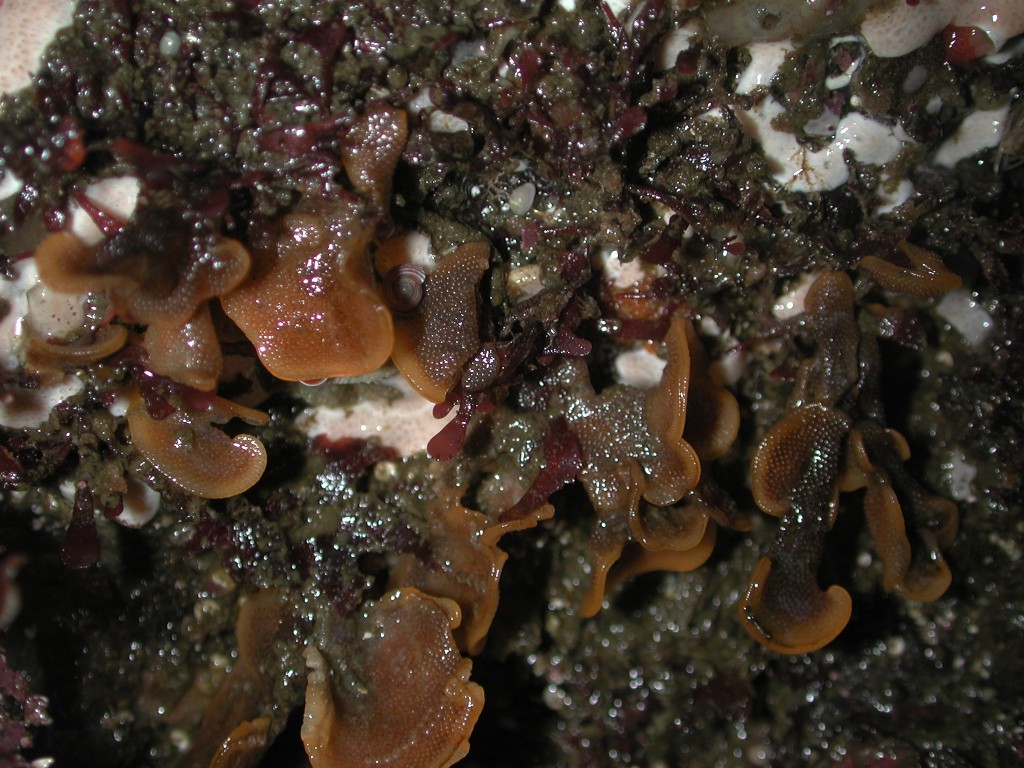Hippodiplosia
insculpta (Hincks,
1882)
Common name(s): Fluted bryozoan, fluted coral bryozoan, sculptured
bryozoan
|
| Synonyms:
Schizoporella insculpta |
 |
|
Phylum Bryozoa
(Ectoprocta)
Class Gymnolaemata
Order Cheilostomata
Suborder Ascophora
Family Schizoporellidae
|
| Hippodiplosia insculpta, found under
a rock. |
| (Photo by: Dave Cowles,
July 2009 ) |
Description:
Bryozoans of Class
Gymnolaemata have zooids
which are polymorphic and usually not cylindrical, with a circular lophophore.
Order Cheilostomata has box-shaped zooids
with calcareous walls, the openings of which usually have opercula.
Embryos are usually brooded in ovicells.
Hippodiplosia insculpta has an erect (not simply
encrusting), leaflike
colony. Most of the frontal
region of the zooecia
is calcified and covered with large pores which are not arranged in
rows.
The frontal
is not
rough. No avicularia
or ascopores
are
present (but Carlton says the suboral depression mentioned below may
have
a tiny avicularium
in Hippoporina insculpta). Ovicells
are large and globular, without pores but with radiating
ribs. The
rim of the aperture of the zooecia
is raised into a peaked mound (umbo) which is separated from the
aperture
by a deep depression (but it has no pointed proximal tooth nor a
U-shaped
sinus). Young colonies may be flat but quickly extend into
leaflike
projections, especially when growing under rocks. Color
yellow to
yellow-brown, often growing in double sheets. May have orange
borders,
especially when ova
are present. Individual zooecia
are about 0.3 to 0.4 by 0.5 to 0.7 mm and rectangular to
hexagonal.
The largest individuals are found at colder latitudes.
Colonies up
to 15 cm diameter.
Note: Part of this species has now been split off as
Hippoporina
insculpta.
How to Distinguish from
Similar Species:
The color and growth form of this colony with the large, striated ovicells
without pores and no avicularia
is distinctive.
Geographical
Range: Alaska to Gulf of
California and Costa Rica
Depth Range:
Lower intertidal to
over 234 m
Habitat:
Rocks, shells, hydroids,
algae, and other bryozoans, on some polychaete worm tubes, pilings;
especially
in areas with substantial water movement.
Biology/Natural History:
This species may sometimes host the entoproct Loxosomella
sp.
Predators include the topsnail Calliostoma canaliculatum.
References:
Dichotomous Keys:
Carlton,
2007 (on Hippoporina insculpta)
Flora
and Fairbanks, 1966
Kozloff,
1987, 1996
General References:
Harbo,
1999
Lamb
and Hanby, 2005
Morris
et al., 1980
Ricketts
et al., 1985
Scientific Articles:
Wollacott, Robet M. and
Wheeler J. North, 1971. Bryozoans of California and northern
Mexico kelp beds. pp. 455-479 in North, Wheeler J. (ed.), The
Biology of Giant Kelp Beds (Macrocystis)
in California.
Beihefts zur Nova Hedwigia Heft 32. Publisher: J.
Cramer, Lehre, Germany.
Web sites:
General Notes and
Observations: Locations,
abundances, unusual behaviors:
Authors and Editors of Page:
Dave Cowles (2009): Created original page
CSS coding for page developed by Jonathan Cowles (2007)
|
